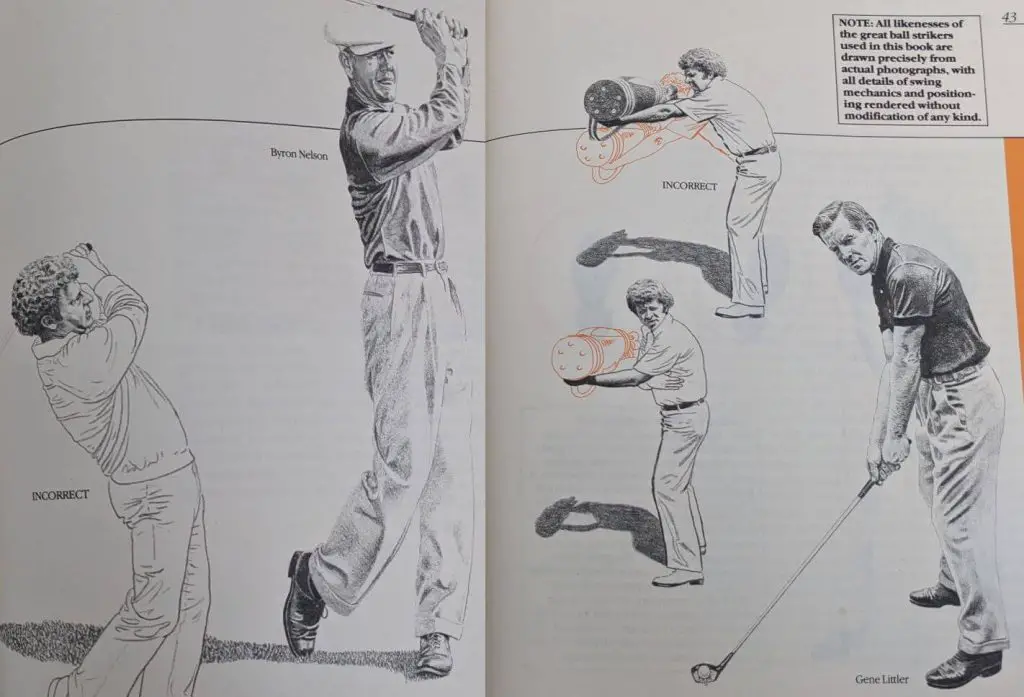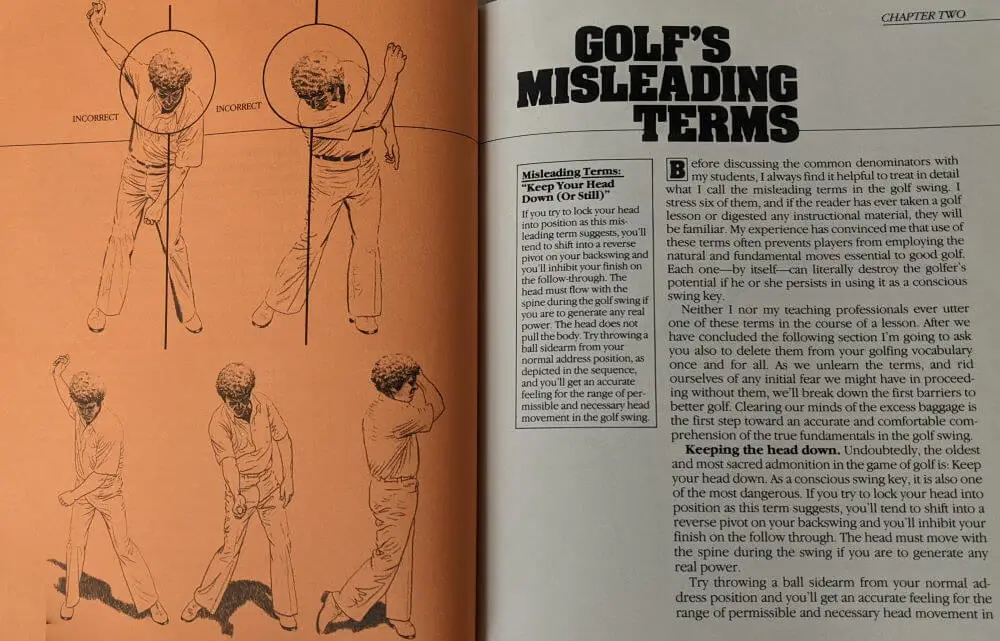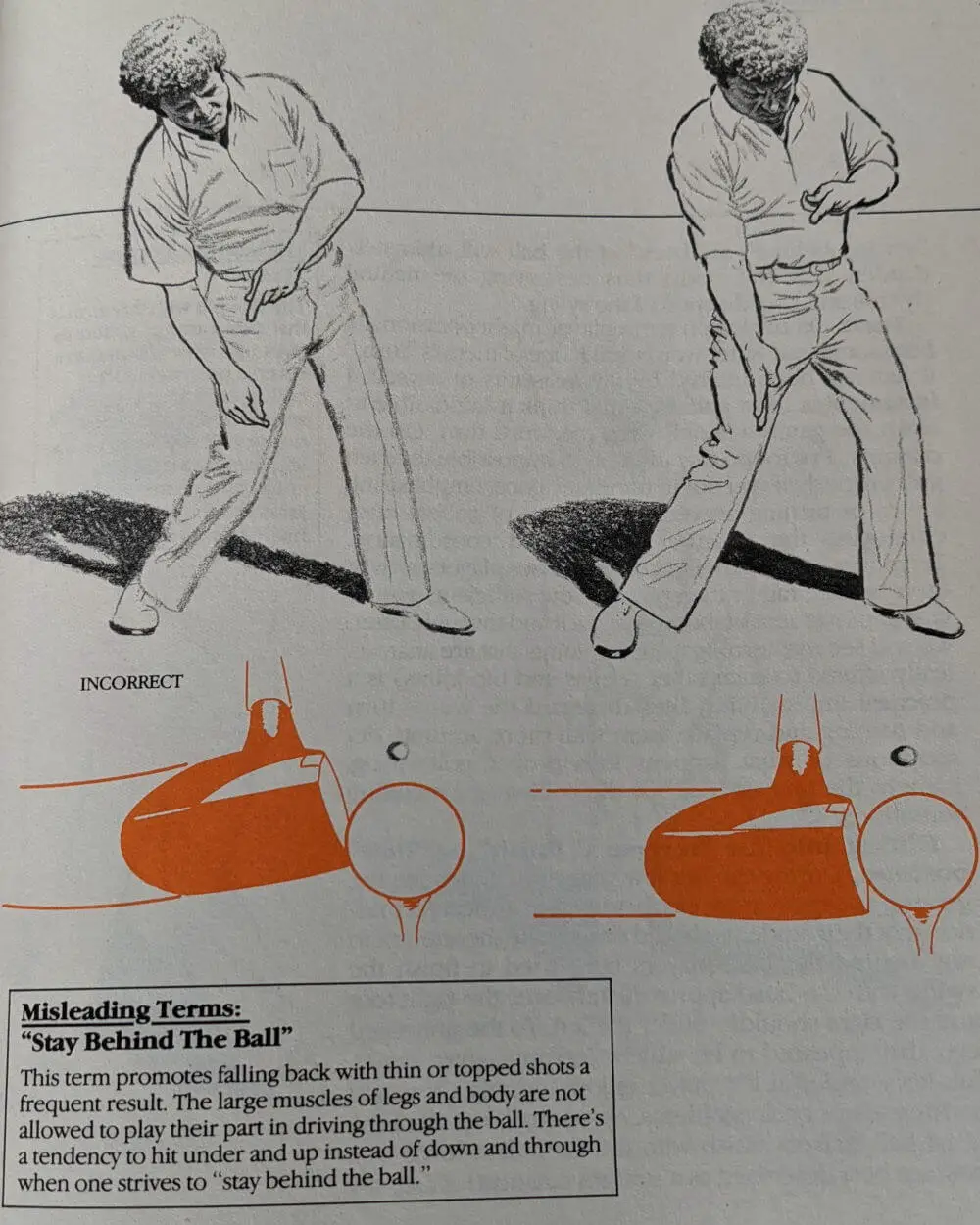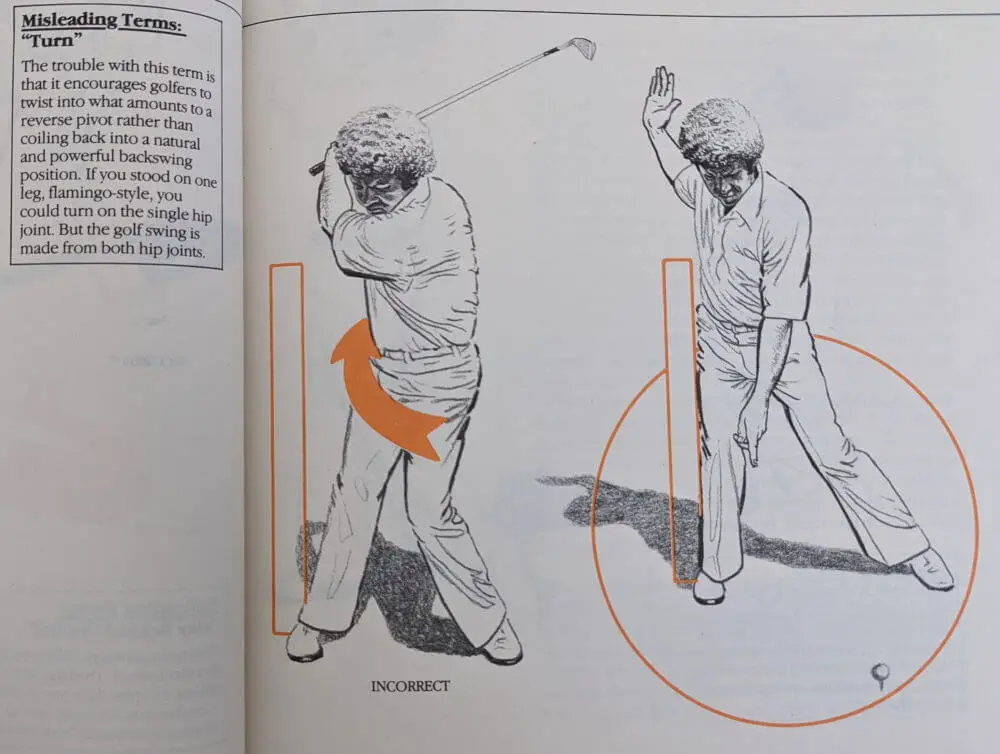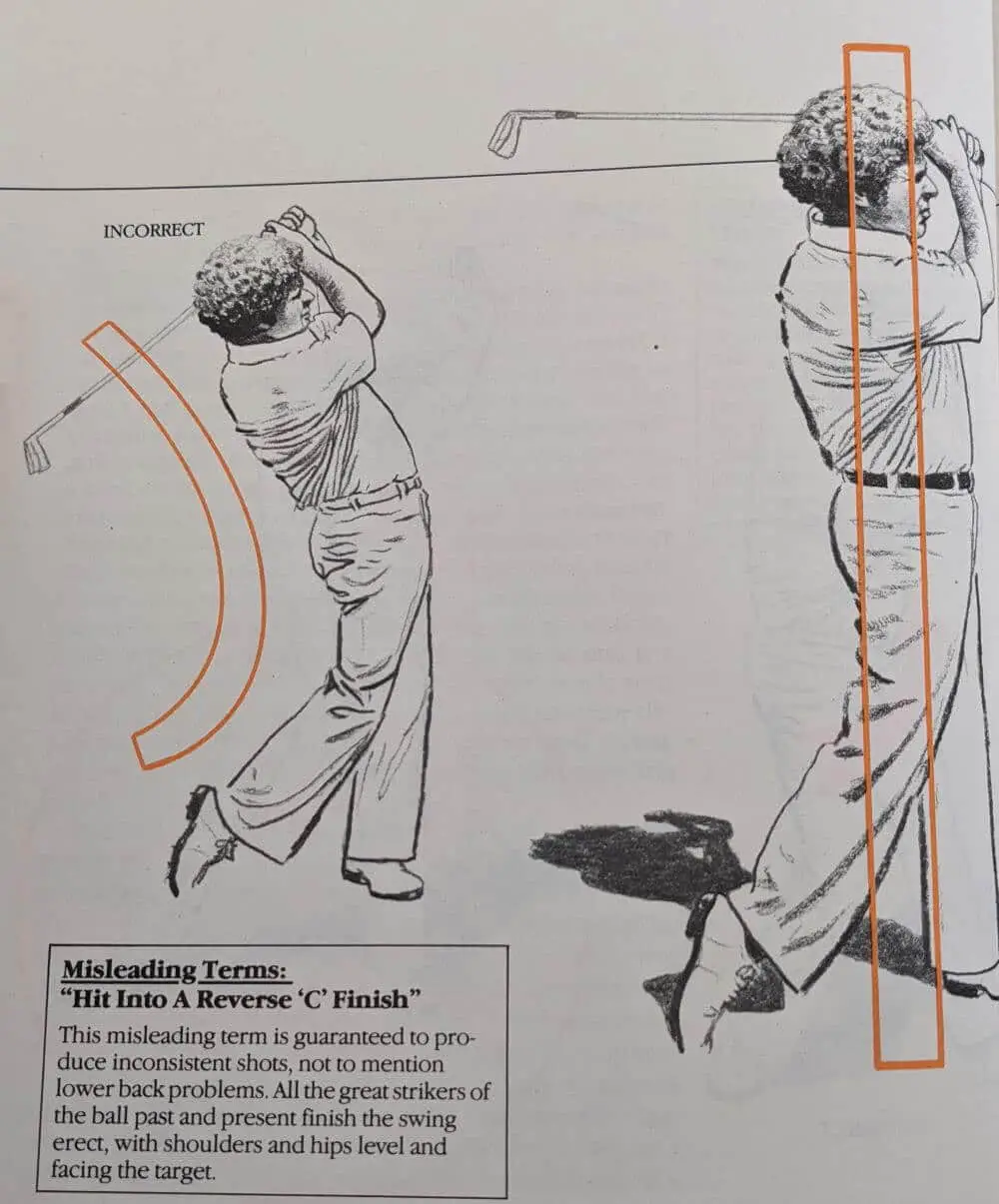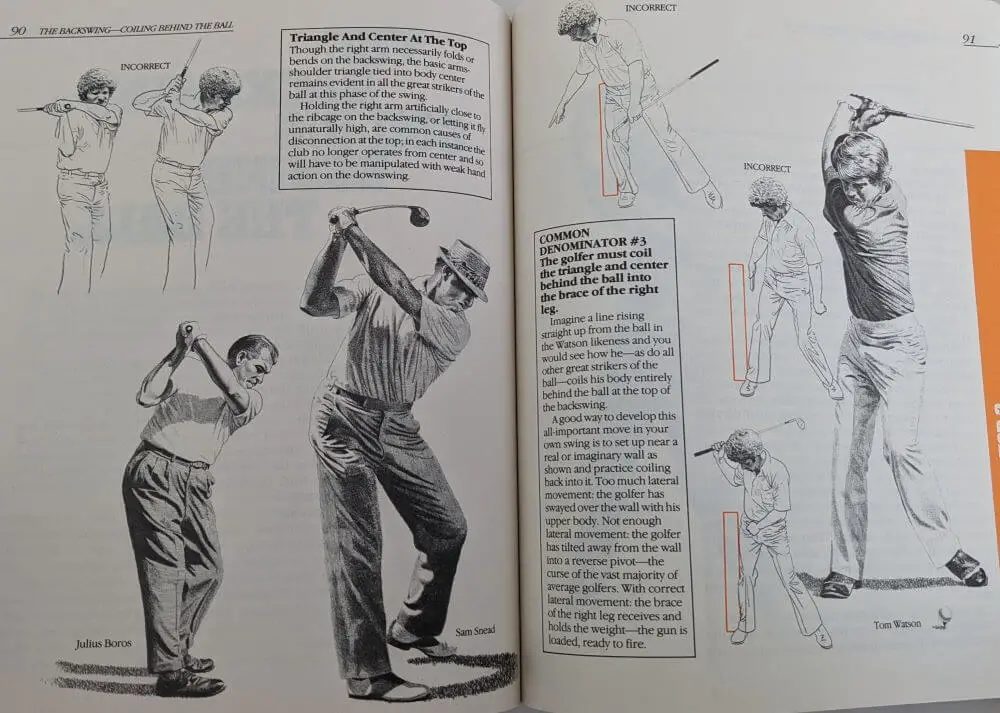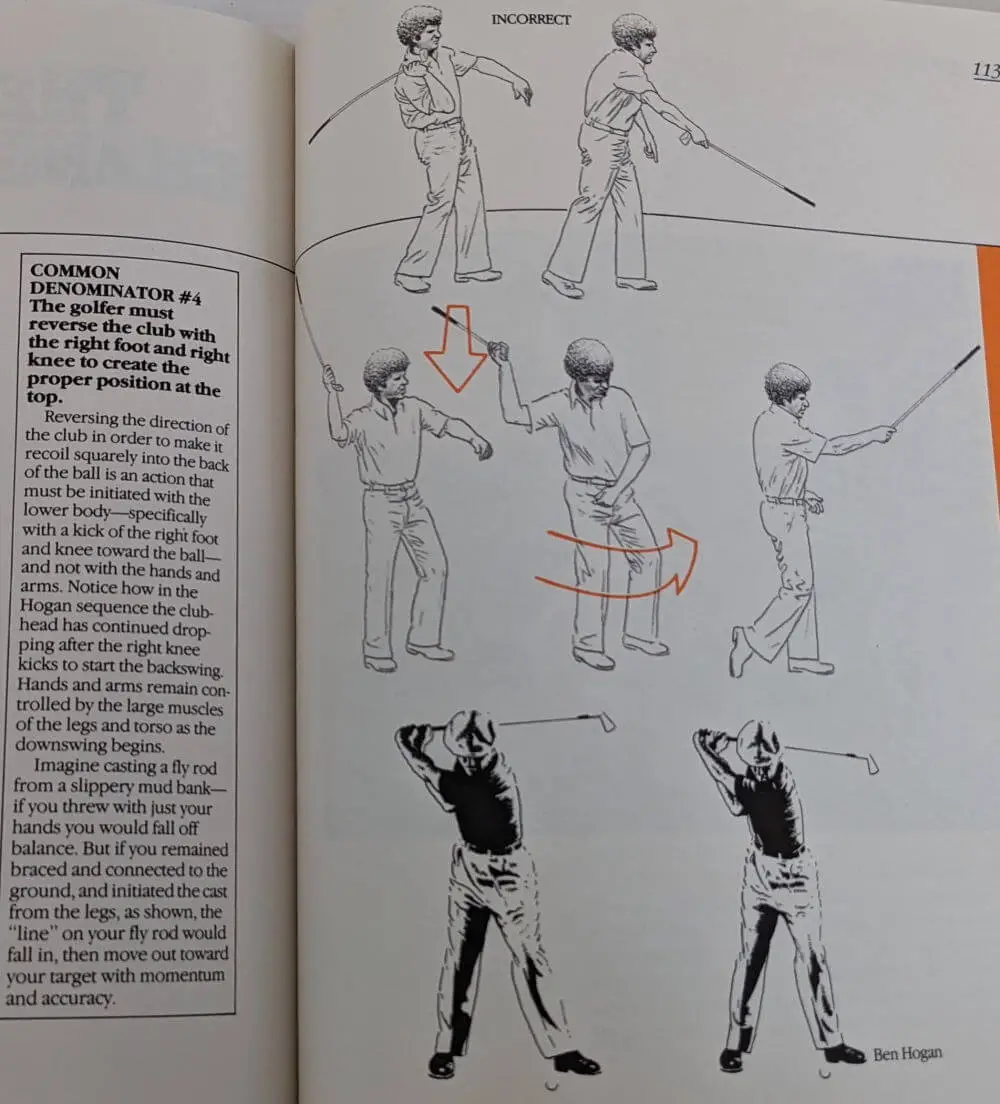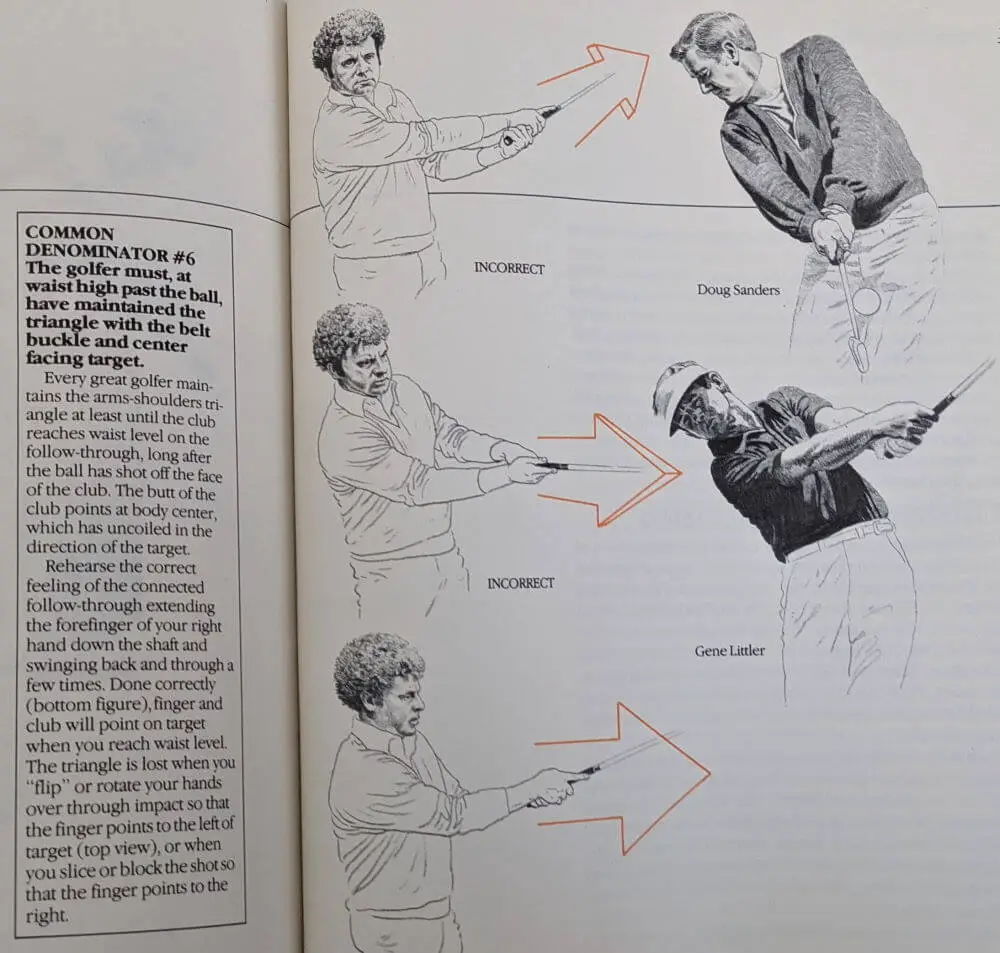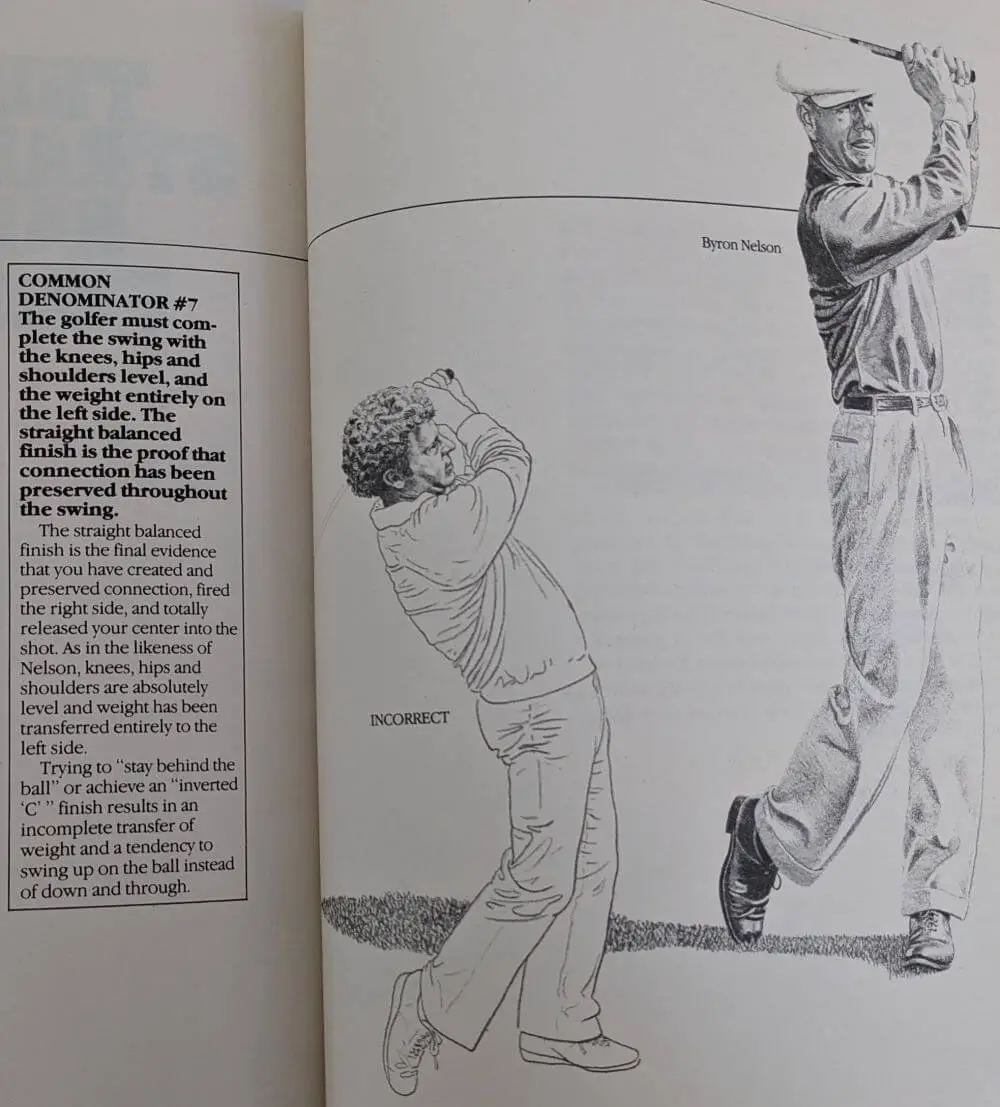Jimmy Ballard is famous for popularizing the concept of connection, and how it is present in all great sportsmen, including baseball players, tennis players, football players, and obviously golfers.
The fundamental idea is that athletes control the hands and the arms with the big muscles of the body (namely the legs, torso and shoulders) rather than with the smaller muscles of the arms and hands.
To quote Ballard “proper utilization of the body initially produces the power which is then transmitted through the arms and hands. Never the reverse“.
In this post, we explor Jimmy Ballard Golf Swing Fundamentals in-depth, including the misleading terms that Ballard hates.
Table of Contents
Golf's Misleading Terms
Misleading Term 1 - Keep Your Head Down
If you try to lock your head into position as this misleading term suggests, you’ll tend to shift into a reverse pivot on your backswing and you’ll inhibit your finish on the follow-through. The head must flow with the spine during the golf swing if you are to generate any real power.
The head does not pull the body. Try throwing a ball sidearm from your normal address position, as depicted in the sequence, and you’ll get an accurate feeling for the range of permissible and necessary head movement in the golf swing.
Here, Ballard is rejecting one of the most common tips in golf, namely to ‘keep your head down’.
From our perspective, Ballard is spot on with this suggestion. Instead of trying to keep your head down (or still) it can be more beneficial to simply keep your eye on the ball. This allows your head to stay in sync with your spine and it allows you to keep your visual focus on the ball.
In essence, when people say ‘keep your head down’ they should really say ‘keep your eye on the ball’. Though these phrases seem similar, they are fundamentally different in terms of how you execute them physically.
Misleading Term 2 - Keep Your Left Arm Straight
Not only does this misleading term generate unwanted tension in the swing, but it produces almost immediate disconnection on the backswing.
Notice how in the incorrect backswing example, the left arm has stretched away from the chest. From this position, the arms will have to pull the club back down to the ball with little help from the major body muscles.
Keeping your left arm straight is another favorite tip shared between high handicap golfers.
From our perspective, people are drawn to this idea because they see players like Tiger Woods keeping their left arm pretty much straight during the backswing.
The real point is that it’s much easier to maintain connection between your left arm and your left shoulder/peck, by allowing some arm bend during the backswing.
Rather than chasing a swing that looks pretty, it is far better to pursue an efficient and repeatable golf swing. In this case, allowing your left arm to bend a bit in the backswing shouldn’t be seen as a swing flaw. Allowing some left arm bend allows you to complete your backswing and load into your right side, which are fundamental to Jimmy Ballard’s golf swing philosophy.
Misleading Term 3 - Pull Down with the Back of the Left Hand
When a golfer tries to follow this advice – the hands get way ahead of the rest of the body and the club slides through the impact area with an open face. Instead, it is better to think of backhanding a chair or similar object, as in lower sequence, and you will achieve the correct downswing action which will square up the clubface at impact.
This misleading term is often touted in golf instruction magazines, and it may explain why so many golfers have a problem with hitting slices.
In essence, if you focus on driving the butt of the club toward the ball as one of your downswing thoughts, it is very easy to leave the clubface open at impact. In almost all cases, an open clubface is the root cause of a slice tendency.
Ballard prefers the visual metaphor of hitting a flat object (like the backrest of a chair) with the back of your left hand. It is fairly easy to experiment with this concept in the comfort of your home.
According to Ballard, focusing on a backhanded slap motion should help you square the face at impact. He is very much against driving the butt of the club toward the ball.
Misleading Term 4 - Stay Behind The Ball
This term promotes falling back with thin or topped shots a frequent result. The large muscles of legs and body are not allowed to play their part in driving through the ball. There’s a tendency to hit under and up instead of down and through when one strives to “stay behind the ball”.
In some respects, Ballard’s advice on this particular misleading term is most pertinent to iron play. This is partly because modern drivers perform best when you hit up on the ball with a positive angle of attack.
It is worth mentioning that Ballard hates the idea of finishing in a reverse C position, where the spine is tilted away from the target in a C shape. Instead, Ballard wants his players to finish in a tall, straight, and balanced position, much like Henrik Stenson and Anika Sorenstam.
Staying behind the ball can encourage the reverse C finish, and it can also result in poor contact when hitting irons.
Misleading Term 5 - Turn
The trouble with this term is that it encourages golfers to twist into what amounts to a reverse pivot rather than coiling back into a natural and powerful backswing position. If you stood on one leg, flamingo-style, you could turn on the single hip joint. But the golf swing is made from both hip joints.
Turning as a swing thought or key causes players to twist their bodies, rather than produce the sufficient, natural lateral movement of the weight back and through. Turning from two hip joints that are anatomically affixed to each other (pelvis and hip joints) is a practical impossibility. Let’s disregard the words turn and turning, and replace them with more accurate descriptions of what happens in a proper golf swing, namely, the proper “coil” or the coiling and recoiling sensations.
To some degree, Ballard was exiled from the professional golf instruction world because of his contrarian ideas regarding “turn” in a golf swing.
You can get a good sense of the ‘turn free’ golf swing that Ballard advocates, by practicing the step drill. In this drill, you start with your feet together, make a full backswing, and then step forward to initiate the downswing.
After doing this several times, you should gain a sense of how to coil force into your right leg during the backswing, and uncoil that force using your left leg during the downswing. This drill has the added benefit of preventing you from swaying off the ball.
Although Ballard disapproves of swaying off the ball, he is very much a believer in coiling fully behind the ball during the backswing. As a result, some people associate Ballard with a swing that involves too much lateral movement.
In reality, Ballard regards the reverse pivot as the number one sin in golf. The problem then, is that encouraging golfers to turn often serves as the catalyst for a revere pivot. In Ballard mind, you will never be a great ballstriker if you have a reverse pivot during the backswing.
Misleading Term 6 - Hitting Into A Reverse 'C' Finish
This misleading term is guaranteed to produce inconsistent shots, not to mention lower back problems. All the great strikers of the ball past and present finish the swing erect, with shoulders and hips level and facing the target.
Tom Watson is perhaps the best example of an an excellent player that was lured into the idea of a reverse C finish.
However, when Watson discovered his swing secret on the practice range in 1991, he effectively learnt how to avoid the Reverse C finish, by rotating around his spine.
To provide a better sense of what it looks like to finish in a straight and balanced position, it is helpful to take a look at the swings of Henrik Stenson and Anika Sorenstam. They literally do what Ballard describes, namely uncoiling through the ball and finishing in a balanced and straight position, with the their weight entirely on the left side.
Jimmy Ballard Golf Swing Fundamentals
Fundamental 1: The golfer must create connection at the outset through a braced connected address position.
To prepare to receive a heavy burden such as a golf bag full of clubs, you would not stand ramrod straight and extend your arms from the shoulder joints.; if you did, you would drop the weight or fall off balance.
If, however, you set your feet apart, flexed and braced your legs, and kept your extended arms connected to the large muscles in your torso, you would have no trouble receiving the weight.
Similarly, great strikers of the ball such as Gene Littler set up in a lithe, athletic manner, with all their large muscles tied into body center, ready to support the dynamic task of executing the full golf swing.
Fundamental 2: The golfer must begin the swing by taking the triangle and center away together
All great strikers swing the club back at least to waist level and sometimes somewhat beyond with the arms-shoulders triangle intact and the club remaining tied into body center, as the Nicklaus image demonstrates.
Note how the body center (see shirt buttons) has coiled with the triangle, ensuring that the big muscles of the torso stay in the act.
Undue small-muscle manipulation during the takeaway, as in trying to o”preset” the wrist cock or to “roll the hands” allows not only the hands but the club to work independently of your body center.
Not how in both incorrect moves above, the butt of the club now points way off-center. A lot of hand manipulation will be required again on the downswing in order to square up the club, and that can’t be done consistently by any golfer.
Fundamental 3: The golfer must coil the triangle and center behind the ball into the brace of the right leg.
Imagine a line rising straight up from the ball in the Watson image and you would see how he-as do all other great strikers of the ball-coils his body entirely behind the ball at the top of the backswing.
A good way to develop this all-important move in your own swing is to set up near a real or imaginary wall as shown and practice coiling back into it. Too much lateral movement: the golfer has swayed over the wall with this upper body. Not enough lateral movement: the golfer has tilted away from the wall into a reverse pivot-the curse of the vast majority of average golfers. With correct lateral movement: the brace of the right leg receives and holds the weight-the gun is loaded, ready to fire.
Fundamental 4: The golfer must reverse the club with the right foot and right knee to create the proper position at the top
Reversing the direction of the club in order to make it recoil squarely into the back of the ball is an action that must be initiated with the lower body-specifically with the kick of the right foot and knee toward the ball-and not with the hands and arms.
Notice how in the Hogan sequence the clubhead has continued dropping after the right knee kicks to start the backswing. Hands and arms remain controlled by the large muscles of the legs and torso as the downswing begins.
Imagine casting a fly rod from a slippery mud bank- if you threw just your hands you would fall off balance. But if you remained braced and connected to the ground, and initiated the cast from the legs, as shown, the “line” on your fly rod would fall in, then move out toward your target with momentum and accuracy.
Personal Note: I absolutely hate Ballard’s description of how to initiate the change of direction using the right foot and the right knee.
From my perspective, the best way to unlock what Ballard means when he talks about ‘firing the right side’ is to make single-handed swings with your right hand.
When you practice right-hand-only swings, you should find it relatively easy to move the right side of your body through the downswing and follow through with power and speed.
Importantly, when you practice right hand-only swings, you really don’t need to think about kicking with your right foot/knee. Instead, you should gain an intuitive understanding of how to fire the right side, while pivoting around your left leg/hip.
Fundamental 5: The golfer must, after initiating the change of direction with the right foot and right knee, immediately release the entire right side and center, insuring that the triangle returns to the original position, squaring the club to the ball at impact.
The triangle of the arms and shoulders is intact at the moment of impact for Trevino, Knudson, Snead and all great strikers of the ball, showing that a total release of power from body center has occurred. The down-the-line view of Trevino demonstrates particularly well how much “right side” gets into a truly effective downswing. The of stored-up energy is achieved from the ground up.
Fundamental 6: The golfer must, at waist high past the ball, have maintained the triangle with he belt buckle and center facing target.
Every great golfer maintains the arms-shoulders triangle at least until the club reaches waist level on the follow-through, long after the ball has shot off the face of the club. The butt of the club points at body center, which has uncoiled in the direction of the target.
Rehearse the correct feeling of the connected follow-through by extending the forefinger of your right hand down the shaft and swinging back and through a few times. If done correctly, finger and club will point on target when you reach waist level. The triangle is lost when you “flip” or rotate your hands over through impact so that the finger points to the left of the target (top view), or when you slice or block the shot so that the finger points to the right.
Fundamental 7: The golfer must complete the swing with the knees, hips and shoulders level, and the weight entirely on the left side. The straight balanced finish is the proof that connection has been preserved throughout the swing.
As in the likeness of Nelson, knees, hips and shoulders are absolutely level and weight has been transferred entirely to the left side.
Trying to “stay behind the ball” or achieve an “inverted C” finish results in an incomplete transfer of weight and a tendency to swing up on the ball instead of down and through.

